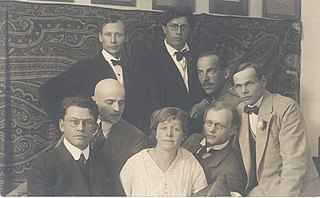 W
WExpressionism is a modernist movement, initially in poetry and painting, originating in Northern Europe around the beginning of the 20th century. Its typical trait is to present the world solely from a subjective perspective, distorting it radically for emotional effect in order to evoke moods or ideas. Expressionist artists have sought to express the meaning of emotional experience rather than physical reality.
 W
WThe Bergen School was a movement in Dutch painting which manifested itself between 1915 and 1925. It is characterised by an expressionist style, influenced by cubism and showing a preference for darker colours. The participating artists lived and worked in or near the artist's village Bergen in the province of North Holland.
 W
WIn Zen, ensō is a circle that is hand-drawn in one or two uninhibited brushstrokes to express a moment when the mind is free to let the body create.
 W
W'Expressionist dance is a term for a movement that arose in 1900 as a protest against the artistic stagnation of classical ballet and towards maturity in the future of art in general. Traditional ballet was perceived as the austere, mechanical and tightly held in fixed and conventional forms.
 W
WFlemish Expressionism, also referred to as Belgian Expressionism, was one of the dominant art styles in Flanders during the interbellum. Influenced by artists like James Ensor and the early works of Vincent van Gogh, it was a distinct contemporary of German Expressionism. Contrary to the more rebellious and erotic nature of many German Expressionist works, the Flemish art of the School of Latem was more oriented towards the farming life, and was expressed in earthy colours and vigorous brushwork. It was also in general more oriented towards France and Brussels than to Germany, and incorporated elements of Fauvism and Cubism, for example the interest in "primitive" art, of both the ethnic and folk traditions. Flemish Expressionists like Spilliaert were more influenced by Ensor and Symbolism, or like Wouters were closer to the vibrant colours used by the Fauvists. The main proponents were Gust De Smet, Constant Permeke and Frits Van den Berghe.
 W
WGalerie St. Etienne is an Expressionism art gallery operating in the United States, founded in Vienna in 1923 by Otto Kallir as the Neue Galerie. Forced to leave Austria after the 1938 Nazi invasion, Kallir established his gallery in Paris as the Galerie St. Etienne, named after the Neue Galerie's location near Vienna's Cathedral of St. Stephen. In 1939, Kallir and his family left France for the United States, where he reestablished the Galerie St. Etienne on 46 West 57th Street in New York City. The gallery still exists, run by Otto Kallir's granddaughter Jane and Hildegard Bachert on 24 West 57th Street. It maintains a reputation as a principal harbinger of Austrian and German Expressionism to the US.
 W
WPsycho-Expressionism refers to an artistic style created in the mid-1990s by Dominican painter Oscar Abreu, in which causal relationships that characterize specific psychological states are represented by Abreu through colorful brush strokes, scratches on canvass and the interplay between the background and subject of the piece.
 W
WThe Siuru literary movement, named after a fire-bird in Finnic mythology, was founded in 1917 in Estonia. It was an expressionistic and neo-romantic movement that ran counter to the Young Estonia formalist tradition.
 W
WThe wordless novel is a narrative genre that uses sequences of captionless pictures to tell a story. As artists have often made such books using woodcut and other relief printing techniques, the terms woodcut novel or novel in woodcuts are also used. The genre flourished primarily in the 1920s and 1930s and was most popular in Germany.